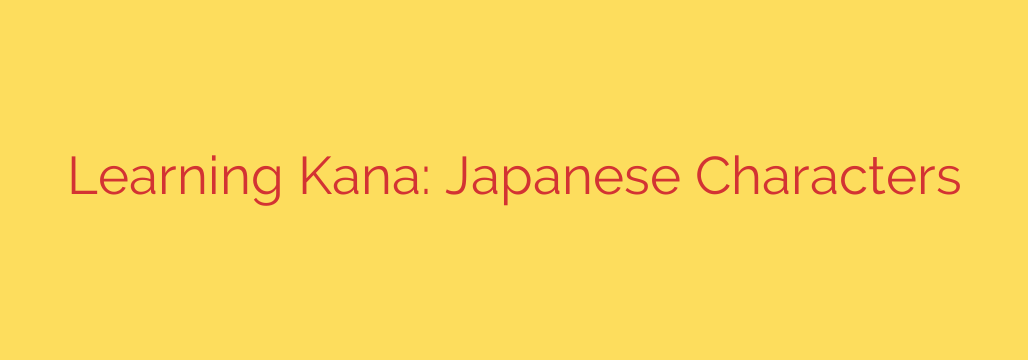
Your First Step to Japanese Fluency: A Beginner’s Guide to Hiragana and Katakana
Embarking on the journey to learn Japanese is an exciting endeavor, but for many, the complex writing system can seem like an insurmountable wall. The good news? It’s far more manageable than it appears. The key is to start with the right foundation. Before you even think about the intricate world of Kanji, your first and most crucial step is to master Kana.
Hiragana and Katakana are the two phonetic scripts that form the foundation of written Japanese. Think of them as the true Japanese alphabet, or more accurately, syllabaries. Each character corresponds to a specific sound, and learning them is the key to unlocking your ability to read, write, and speak the language correctly.
The Three Pillars of Japanese Writing
The modern Japanese writing system is a fascinating blend of three distinct scripts working in harmony:
- Hiragana (ひらがな): A flowing, cursive-style script used for native Japanese words, grammatical elements like particles, and word endings.
- Katakana (カタカナ): A sharp, angular script primarily used for foreign loanwords (like “computer” or “coffee”), onomatopoeia, and for adding emphasis.
- Kanji (漢字): Logographic characters borrowed from Chinese, used to represent entire words or concepts. There are thousands of them, but they are learned gradually over time.
For any beginner, the focus must be squarely on Hiragana and Katakana.
Meet Hiragana: The Heart of Japanese Grammar
Hiragana is arguably the most important script to learn first. Its smooth, rounded characters are used for the grammatical nuts and bolts of the language. When you see verb conjugations, particles (like は, を, が), and native Japanese words that don’t have a common Kanji, you’ll be seeing Hiragana.
Every sound in the Japanese language can be written in Hiragana. This makes it the phonetic backbone of your studies. For example, the word for “cat,” neko, is written ねこ. The verb “to eat,” taberu, is written たべる. Mastering this script allows you to start reading and writing full, grammatically correct sentences right away.
Meet Katakana: The Script for a Global Language
Katakana characters represent the exact same sounds as Hiragana, but they look different—more rigid and geometric. Their primary role is to handle words imported from other languages. Given the amount of English and other foreign vocabulary in modern Japanese, Katakana is essential for navigating daily life in Japan.
For example:
- Coffee is コーヒー (kōhī)
- Computer is コンピューター (konpyūtā)
- America is アメリカ (amerika)
Learning Katakana is non-negotiable if you want to read menus, understand modern media, or even browse a Japanese website. It is your tool for interpreting the global influence on the Japanese language.
Why You MUST Learn Kana Before Anything Else
Some beginners try to take a shortcut by relying on Romaji—the romanization of Japanese sounds using the English alphabet. While it can seem helpful at first, this is a trap that can severely hinder your progress.
Relying on Romaji is one of the biggest mistakes a new learner can make. It prevents you from engaging with authentic Japanese materials and can lead to poor pronunciation habits. True fluency begins with reading the language as it is actually written.
By mastering Kana, you will:
- Develop accurate pronunciation from the start.
- Be able to read native materials like children’s books, manga with phonetic guides (furigana), and basic signs.
- Gain the ability to use Japanese dictionaries and learning resources effectively.
- Build a solid foundation that makes learning Kanji much easier in the future.
Actionable Tips for Mastering Kana
Learning the 46 characters in each script might sound daunting, but with the right strategy, you can master them in just a few weeks.
Use Mnemonics: This is the most effective method for many learners. A mnemonic is a memory aid that creates a visual or conceptual link to a character. For instance, the Hiragana character い (i) looks like two eels, and the Katakana character メ (me) looks like an “X marks the spot,” reminding you of a treasure map.
Write Them Down: Do not skip writing practice. The physical act of writing the characters helps cement them in your memory. Pay close attention to the correct stroke order, as it’s essential for writing legibly and quickly. Print out practice sheets and drill the characters until they become second nature.
Leverage Technology: There are countless high-quality apps and websites designed for learning Kana. Flashcard systems like Anki are perfect for using spaced repetition to drill characters into your long-term memory. Find an app that includes both recognition and writing practice.
Expand Your Knowledge: Once you know the basic characters, you’ll learn about small additions called dakuten (゛) and handakuten (゜). These marks change the sound of a character. For example, は (ha) becomes ば (ba) with a dakuten and ぱ (pa) with a handakuten. You will also learn about combined sounds, known as yōon, like きゃ (kya) and しょ (sho).
Your journey into the beautiful and rich Japanese language starts here. Taking the time to build a strong Kana foundation is not just a recommendation; it is the single most important investment you can make in your future fluency.
Source: https://www.linuxlinks.com/kana-learn-japanese-characters/








